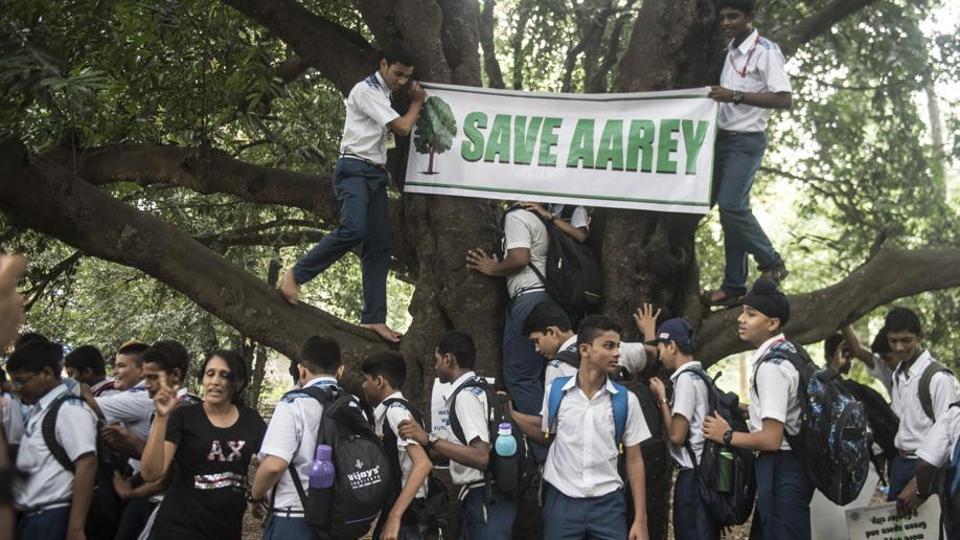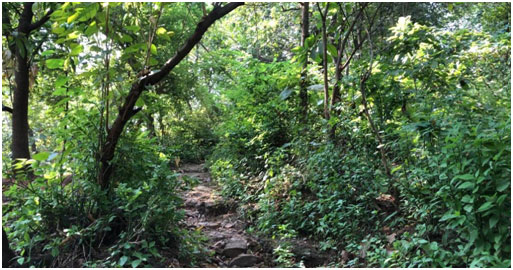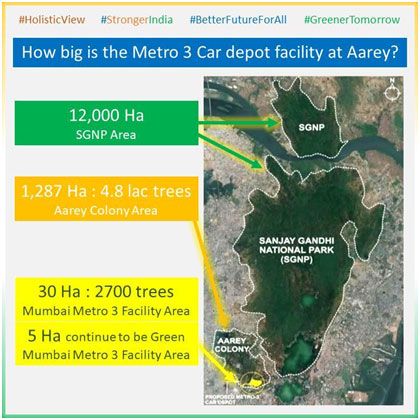The “Save Aarey” Movement has been fighting its fight for 5 years now. The impact of this movement has been large enough to include people from all walks of life in Mumbai who came together to save the “city’s lungs”. With protests, petitions before the Court and the actions of BMC and its agencies being the key factors of this movement, let’s take a bird’s eye view of what conspired between the protests and the culminating Bombay High Court judgment which has come as a rude shock to the residents of Mumbai.

The #SaveAarey movement is unique. Read on to understand the Issue from both angles: Saving our Mumbai and from the votaries of a certain kind of ‘development.’
What happened today and what lies ahead
Before the Bombay High Court were three petitions, two of which were filed against the decision of the Tree Authority and one was concerned with declaration of Aarey as a “forest” in legal terms.With the Bombay High Court dismissing all petitions pertaining to Tree Authority’s decision to allow MMRCL to cut down more than 2,600 trees in Aarey Forest, the future of Aarey remains precarious.
With no stay on the felling of trees, will the MMRCL authorities begin the destructive felling rightaway?
How soon will the petitioner groups appeal this decision?
What is Aarey?
The Aarey forest, located in the Northern suburbs of Mumbai, is the only green cover in the region, and is known for its lush greenery, with tall trees, grasslands and rocky hills. Around 27 Adivasi settlements are spread across Aarey. The Adivasis have been living in the area since before the Aarey Dairy farm was set up in 1951. In the past, these Adivasis have lost chunks of the land to projects such as NSG training centre, Film City, and housing complexes, among others. Despite protesting and raising their voices.

What is the connection between Aarey and Metro III Project?
The Metro III project is going to cost around Rs. 23,316 crore, and the depot is planned to be built on 34 hectares of land of Aarey which means felling down of approximately 2,700 trees. Mumbai Metro Rail Corporation Ltd (MMRCL) is a joint venture of Government of India and Government of Maharashtra, which is implementing Mumbai’s first fully underground Metro and accordingly it seeks to build a car shed for Metro in Aarey.
Why are we protesting?
It isn’t everyday that people from all walks of life in a Metropolitan city come together to take a stand against demolition of its green cover. Over the past few months the protests have gained much traction and have been actively and prominently covered by news media as well. There are a lot of stakeholders who stand to being affected due to the felling of about 2,700 trees in Aarey.
The Founder of Aarey Conservation Group, which is one of the leading groups in the “Save Aarey” campaign, Ms. Amrita Bhattacharjee says that the movement started 5 years back and now a younger generation has started partaking in the protests.
The Aarey forest is home to varied species of flora and fauna and also wildlife. Felling of trees here would mean encroachment which could lead to destruction of a well bred ecosystem.
How are we protesting?
People from many walks of life, concerned citizens formed a three kilometre long human chain, in September 2019 to protest against the felling of the trees. The human chain became a trend thereafter and people started gathering and forming a chain, every Sunday of the following weeks. The issue also inspired three young rappers to take up the cause and express their anguish and concern in a rap video
Who will be directly affected due to construction of the Metro car shed?
Aarey is home to Adivasis, majorly Warli Tribe, living in 27 hamlets since generations. Naturally, they have a staunch opinion against the construction of the Metro shed.
See the full story on what the Adivasis are fighting for here: Aarey Adivasis demand forest rights, implementation of FRA
Prakash Bhoir is a fiery Adivasi activist from Aarey, whose consistent initiatives have helped shed light on the condition of Adivasis in this forest. Per Bhoir, the multiple development projects in the area have impacted Adivasis’ farming, their cattle, as well as the wildlife. Bhoir remarks that any time one talks about the supposed development projects, it is the Adivasis who are sacrificed at the altar of this development.
Is Aarey a Forest?
During the hearing of the PIL filed by Vanashakti, to declare Aarey as a forest, before the Bombay High Court, petitioner activists told the Hon’ble High Court that a ‘survey’ to determine the area’s ‘forest status’ was conducted through a view from a hillock in 1997. Since the term “forest has not been defined in the Indian Forest Act (1980) and Forest Conservation Act (1927), one cannot be certain. There are no specific parameters to determine a forest area in Maharashtra despite of a 1997 Supreme Court order directing states to identify forests within their territory. During the hearing, a renowned botanist, Dr. Rajendra Shinde said that out of the list of 80 species of trees in Aarey 30 are indigenous and typical forest species and also added that as every tree has different varieties of organisms on it, every tree is an ecosystem in itself.
The Mystery of the Tree Authority and its decision
In August 2019, MMRCL put its proposal for cutting down trees for the Metro III car shed before the Tree Authority which comprised of a panel of three experts. As per a news report by Outlook India, the Authority’s decision granted MMRCL permission for felling 2,702 trees of which 2,238 were proposed to be cut and the rest were to be transplanted. However, the manner in which this decision was taken is contentious since one of the experts claimed that due to there being a lot of commotion, hervote was misconstrued.According to a report by The Times of India, she stated “The was a lot of confusion. Some people were demanding more time. When the proposal was passed, I was under the impression that it was to take the decision later. But after some time, I realisedit was for the Metro proposal. We did not have any time to clarify as there was a lot of commotion.” Few other members of the Tree Authority alleged that there are discrepancies in the tree inventory data
Legal Background of the issue
NGO Vanashakti had approached the National Green Tribunal (NGT) against the felling of trees by MMRCl for Metro III car shed. The NGT, however, asked the petitioner NGO to approach the High Court or the Supreme Court claiming it doesn’t have the jurisdiction to decide whether Aarey was a forest.
NGO Vanashakti had approached the Bombay High Court seeking a declaration that entire 1280 hectare area of Aarey Colony as ‘reserved Forest’ or a ‘Protected Forest’ as the case may be, under the Indian Forest Act, 1927.The decision of this petition would have proved to be extremely significant in the background of another petition with the Bombay High Court contending permission given by the Tree Authority’s to cut about more than 2,600 trees. The petition was, however, dismissed by the Bombay High Court citing that a petition raising the same question was decided in the negative by a Bench of the same Court and appeal is pending before the Supreme Court of India.
The judgment can be read here
Two other petitions were filed by environmental activist Zoru Bathena as well as by a BMC Corporator one Mr. Yashwant Kamlakar Jadhav against the decision of the Tree Authority permitting cutting down of more than 2,600 trees. The Bombay High Court dismissed both petitions and it stated in its judgment that “the fact that the proposal of the project proponent was scaled down with reference to the number of the trees to be felled is itself proof of the decision making process being fair, transparent and based on reason.” The Court, in its judgment dismissing both petitions, concluded, “the Greens fail even in these two petitions, but not on account of sailing their boats in the wrong channel, but on merits.”
Is there no other land for the Metro project?
In 2016, the Save Aarey Group had identified land in Kanjurmarg, near Jai Ambe Nagar as an alternative site for the metro car shed and suggested the same to the government for consideration. Thereafter, it became known that this plot is free from litigation and can be used to locate the Metro 3 car shed. The occupier was trying to sell the land or create a third party interest on it. Kindly note that the said land falls under CRZ 1 and the same is shown in the DP maps.
The Hindustan Times, in its edition on January 17 had reported that city suburban collector in a first of its kind decision had taken back 66 acres of government land in Kanjurmarg that had been leased to a private company for industrial development in 1984, following violation of lease agreement. The estimated value of this land is now Rs3,000 crore.
Before the Bombay High Court, activist and petitioner Zoru Bhathena had raised a contention that the MMRCL and BMC had the alternative of constructing the Metro car shed in Kanjurmarg and the government was in possession of close to 1,668 hectare land and only 242 hectare was under litigation, while Metro car shed required only 41 hectare.
NGO petitioners battling the issue in the courts thereafter urged government to accept this “win win” situatio which would not just save trees but also allow the MMRCL to develop the metro rail corridor.
Alas, the government refused to yield.
Poster Wars
The juxtaposition of justification of the project and the protest against it, in pictures:
The protestors point of view


The Supporters’ point of view:




